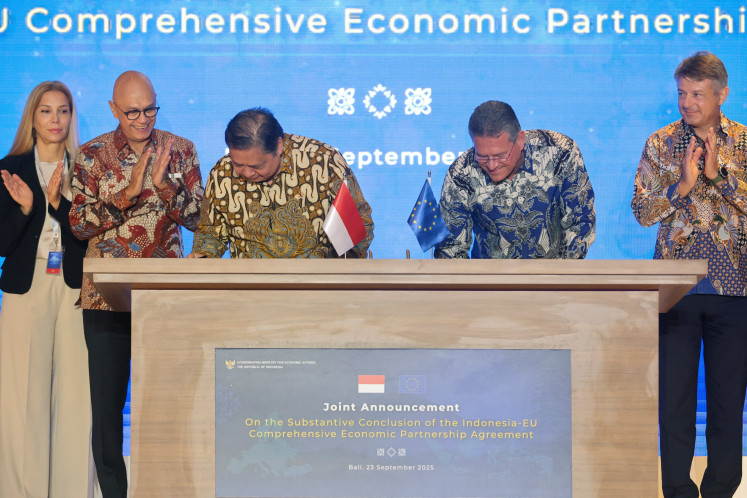Popular Reads
Top Results
Can't find what you're looking for?
View all search resultsPopular Reads
Top Results
Can't find what you're looking for?
View all search resultsBI rate cuts make no impact on growth in bank lending: Report
Taking too long: Customers queue Saturday at an ATM in a mall in South Jakarta
Change text size
Gift Premium Articles
to Anyone
Taking too long: Customers queue Saturday at an ATM in a mall in South Jakarta. Despite sharp cuts in Bank Indonesia’s key interest rate since December, growth in bank lending remains slow. With the BI rate at 7.5 percent, interest rates for bank lending remain high at 12 to 16 percent, discouraging companies and individual consumers alike from borrowing, thus doing little to get the wheels of the economy moving any faster. JP/P. J. Leo
Despite sharp cuts in the central bank’s key interest rates since December, growth in bank loans remains slow as the sector grapples with rising bad loans and — for small and medium lenders — tight liquidity.
Bank Indonesia has since December slashed its benchmark interest rate by 200 basis points, the latest cut being last Friday, to help bolster domestic demand and stimulate economic growth slowed by a drop in exports amid a global economic meltdown.
However, while the BI rate now stands at 7.5 percent, interest rates for bank lending remain fairly high at around 12 to 16 percent, discouraging companies and individual consumers alike from borrowing, thus doing little to get the wheels of the economy moving any faster.
Businesses also claim that banks have been applying stricter and tighter requirements in handing out loans.
Bank Mandiri, the country’s largest lender by assets, says such a trend may have a lot to do with the banking sector’s cautiousness in giving out loans amid a rising trend in nonperforming loans (NPLs), and also a lack of liquidity in small and medium banks.
“Smaller banks will keep their interest rates high because they are worried their clients will transfer their savings and deposits to larger banks, which would then hurt their liquidity even more,” Mandiri president director Agus Martowardoyo said Friday at a gathering.
“Banks also have to face other problems in lowering interest rates, such as the high cost of funding, capital, risk, management and competition.”
According to BI data, there was no significant amount of increase in loans from commercial banks since the first BI rate cut last December.
The report shows that bank loans for investment only increased by 1.3 percent to Rp 259.3 trillion in January from Rp 255.9 trillion from the previous month, while lending for consumption barely rose to Rp 367.2 trillion in January from Rp 367.1 trillion in December.
Lending for working capital even decreased to Rp 663.4 trillion in January from Rp 684.7 trillion in December.
A growing trend in NPLs may also have contributed to the trend.
The BI report shows that NPLs have been on the rise since December.
The percentage of loans that are NPLs increased to 4.2 percent in January from 3.8 percent in December. Last Friday, BI Governor Boediono said that in February, national banks’ gross NPL rate rose by another 0.1 percent to 4.3 percent.
The report says that NPLs increased by 10.5 percent on average in three major segments — working capital, investment and consumption — ever since the first BI rate cut in December.
By function, the NPLs dedicated for the working capital segment rose 10.5 percent in January from the previous month; for the investment segment they increased 13.5 percent, and for the consumption segment they rose 7.7 percent.
Aviliani, an economist from the Indonesian Development of Economics and Finance (INDEF), shared the same opinion with Agus that scarcity in liquidity as well as rising NPLs had slowed down growth in bank lending.
“The first factor is from the funding side: large corporate banks have no problem giving out loans, but smaller and mid-size banks are currently facing a liquidity problem that prevent them providing loans,” she said Saturday.
“Second, smaller banks set high annual deposit rates of between 12 and 14 percent in order to gather cash from the public to increase liquidity. With such a high percentage on the deposit rates, no wonder they choose to set around credit rates of around 16 to 17 percent.” (hdt/fmb)
Credit of Commercial Banks Based on Type of Use (In Bilion Rp)
Types of Use October 2008 November 2008 December 2008 January 2009
Working Capital 687,229 705,366 684,672 663,357
Investment 250,188 255,984 255,900 259,317
Consumption 360,443 363,973 367,117 367,165
Total 1.297,860 1.325,323 1,307,688 1,289,839
Non Performing Loan of Commercial Banks Based on Type of Use (In Billion Rp)
Types of Use October 2008 November 2008 December 2008 January 2009
Working Capital 22,250 24,637 22,953 25,361
Investment 11,403 11,807 9,607 10,904
Consumption 9,669 9,750 9,313 10,030
Total 43,322 46,194 41,873 46,295
Source: Bank Indonesia










